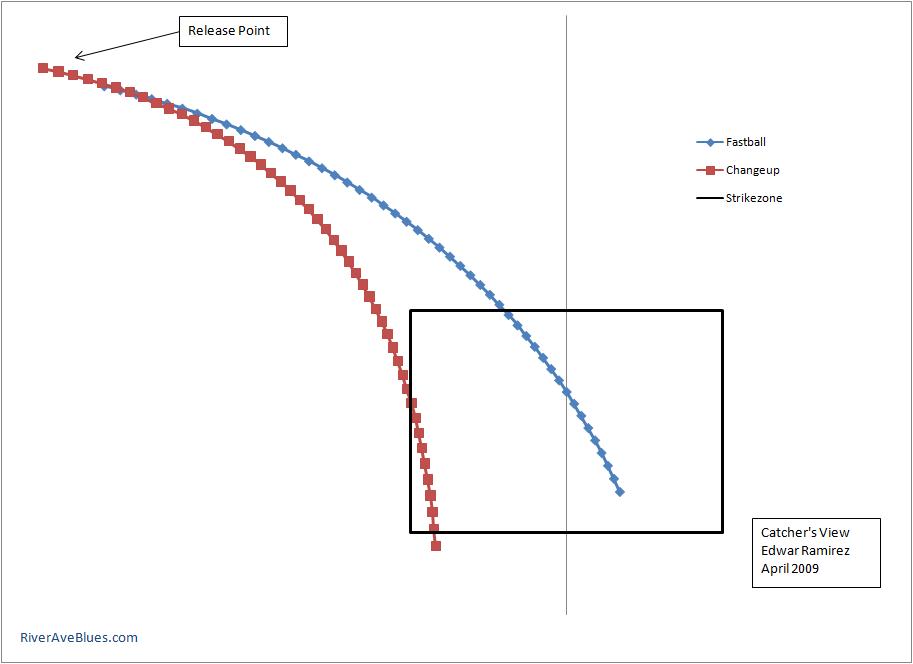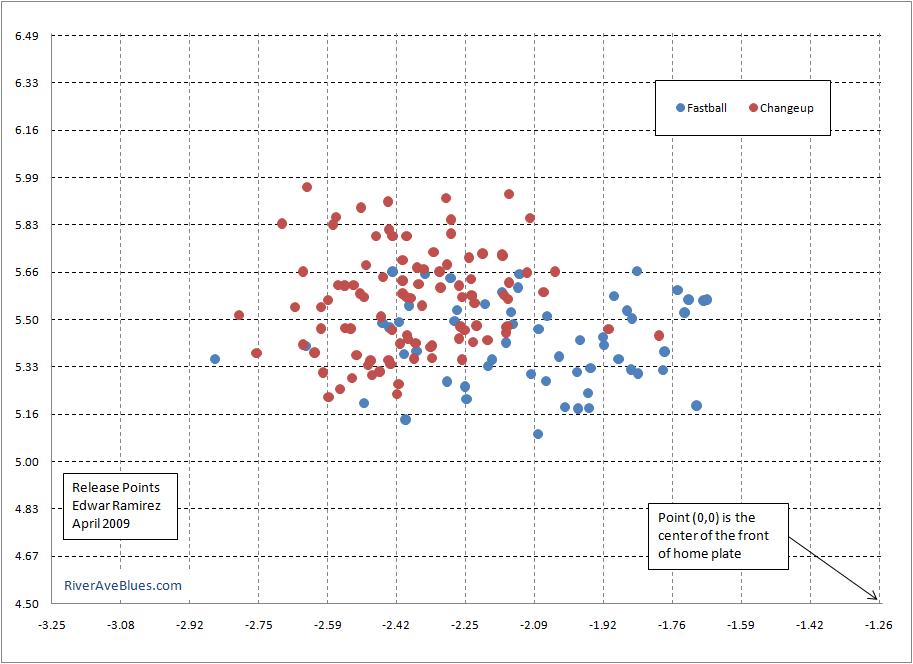Thanks to a trio of abysmal Chien-Ming Wang starts, the Yankees’ bullpen has thrown 46.2 innings this year, fourth most in the AL. Edwar Ramirez has bit the bullet twice in relief of Wang, throwing a then-career high 51 pitches on the 13th before establishing another career high with 58 pitches on the 18th. All of that extra work gave us a meaningful enough sample of pitches that we can use to take a closer look at Edwar’s one trick pony act.
Let’s get it started with the usual, the pitch trajectories. I’m only going to look at Edwar’s fastball and changeup, but he does through the occasional slider and it’s clearly his third offering. In fact, he’s thrown just eight this year according to Pitch f/x’s classifications, and that’s out of 162 total pitches. As with all of our Pitch f/x graphs, you can click these for a larger view. Let’s start with the bird’s eye view:
This view is pretty useless for fastballs and changeups, but you can get an idea of how quickly each pitch gets on a hitter. Each tick mark along the flight path represents 1/100th of a second, so the farther apart the ticks, the faster the pitch. Edwar’s changeup takes about 4/100ths of a second longer to get to the plate than his fastball, and you can see that difference in velocity by looking at the tick marks. Here’s the view from first base:
This view is always fun because he can get a real good look at how the pitches move vertically. Obviously Edwar’s changeup has a considerable amount of drop, and that sink really starts to kick in when the pitch is more or less halfway to the plate. Let’s check out the view from behind the dish:
Edwar’s changeup has fades down and away from lefthanders considerably, which leads you to believe that he’d be more effective against batters of the opposite hand. The stats don’t jive with that though:
Career vs RHP: .219-.318-.438 against, 33.3 K%
Career vs LHP: .262-.368-.459 against, 22.4K%
They’re both pretty significant samples (171 plate appearances vs RHP, 201 vs LHP), so there’s no funny business going on. I dunno what that’s about, maybe Edwar is just more comfortable throwing to his arm side, which allows him to more effectively bust righties inside. Just a guess on my part.
Lastly, here’s his release points:
That’s a pretty tight set of release points, generally about 8-inches tall and 10-inches wide, save for a few extraneous pitches. Edwar has one of best righthanded changeups in the game, and there are two main factors contributing to it’s effectiveness:
- Movement: You can see it in the graphs above, Edwar’s change moves both horizontally and vertically. It’s hard enough to hit a pitch that moves in just one direction, nevermind two.
- Deception: This is the big one. Edwar throws his change from the same arm slot with the same arm speed as his fastball, but there’s no way for Pitch f/x to measure this stuff (or maybe there is, I dunno). By throwing his two main weapons the exact same way, hitters have no idea what’s coming, and have to figure out whether the pitch is a high-80’s fastball with little movement or a high-70’s change with redic fade while the pitch in mid-flight.
We’re all familiar with the concept of Good Edwar and Bad Edwar; Good Edwar is the one that’ll march out of the pen and strikeout the side, Bad Edwar is the guy that’ll walk the farm before serving up a gopher ball or two. It seems like we either get one or the other with very few in-between outings. Later on in the season when we have more data I intend to breakdown Good Edwar and Bad Edwar side-by-side to see if there’s a discernible difference.




Leave a Reply
You must be logged in to post a comment.